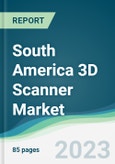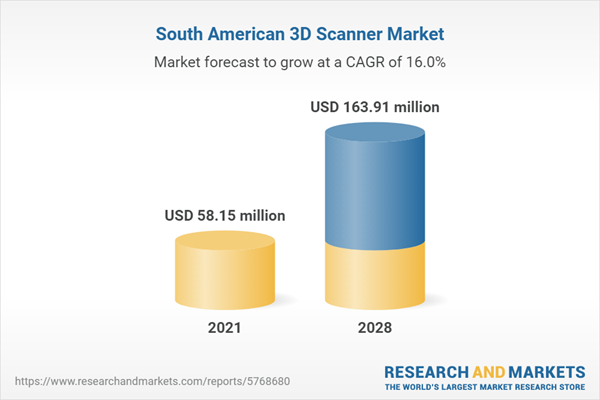The South American 3D scanner market is expected to grow at a CAGR of 15.95%, from an initial value of US$58.154 million in 2021 to US$163.905 million in 2028.
The ongoing technical innovation, such as an increase in 3D content and continual advances in 3D modeling and mapping technology, will fuel South American demand for a 3D scanner. The increased emphasis on quality control because of severe competition drives up requests for these scanners. Additionally, high-speed development and enhancement in 3D scanners due to ongoing R&D spending are predicted to boost 3D scanner demand. However, unfavorable economic and political conditions in Argentina and Brazil may stymie the continued growth of these scanners throughout the predicted period.3D scanning is increasing in popularity in the business and has asserted itself as an important tool in the product lifecycle management process (PLM). It has drastically transformed how firms in different industries model, create, and visualise the actual world. Because of developments in scanning across a range of areas, from engineering and production to healthcare, the method of measuring and documenting has been standardized and improved. Current measurement professionals can also become more productive by adding three-dimensional scanning in their process. Moreover, companies in the South American region have launched products to implement the usage of 3D scanners in diverse industry segments.
The South America 3D scanner market is driven by growing demand from end-user industries.
The South America 3D Scanner Market is seeing considerable revenue growth as a result of various promising aspects, one of which is the widespread implementation of 3D scanning technology in commercial applications. Technology's adaptability will be tailored to fulfil a variety of professional demands across sectors. In the medical industry, for instance, 3D scanners are used to model parts of the body in 3D, which is then utilised to make prostheses. It is also utilised to aid wound healing and to create a variety of body implants.Due to the increased need for highly precise 3D scanning, the South American 3D scanning market share is predicted to expand significantly throughout the forecast period. The continuous increasing technical breakthroughs in 3D scanning have fueled the market expansion. Since the introduction of 3D scanners, there has been an increase in the demand from industries such as automotive production and construction for quality control, surveying, and inventory management. Furthermore, with the rise of these industries, the requirements for 3D scanners in this region are anticipated to surge during the projected period.
Key Developments.
- In September 2022, Scantech3D an expert in the field of 3D scanners launched its latest version of the 3D scanner SIMSCAN. It’s a portable 3D scanner designed specifically for professional use. SIMSCAN is highly efficient, with accuracy up to 0.20mm. It is also energy efficient as it consumes low power.
- In August 2020, Evatronix a 3D scanner company expanded its distribution of evils can 3D scanners in South American countries. They have signed a contract with the Mexican firm GENUS_AMERICA. According to the agreement the Mexican company will distribute Evatronix scanners such as heavy-duty range, laser scanners and eviXmatic automatic scanning and measurement system across Latin American countries.
- In August 2022, researchers from the MIT Senseable City Lab used 3D technology to map Brazil's largest favela, Rocinha, in Rio de Janeiro. The favela was mapped by the researchers using portable 3D scanners. The intention was to use it for the creation of a virtual representation of Rocinha using the 3D laser scanning technology known as LiDAR - light detection and ranging - for the Favelas 4D project. Carlo Ratti, an Italian architect, is in charge of the project. Favelas 4D aims to ameliorate the circumstances in the favelas and offer residents access to official assistance, management, and economic prospects.
By country, Brazil is expected to show considerable market growth due to the growing end-user industries along with various vital market developments.
The end users in industries like construction, mining, and automotive have been able to utilise this mode of scanning due to technological improvements in the product offerings. For instance, in May 2021, the architecture of Rocinha, which is Brazil's biggest and most developed favela, was studied by researchers at the MIT Senseable City Lab using handheld 3D scanning technology by the utilisation of point cloud data from portable LiDAR scans. This expanding use of this technology is thus expected to drive the Brazilian market. Further, 3D scanners are used by the aerospace industry for the inspection of aircraft components as well as turbine blades. Further, the automotive sector in Brazil has been on an upward rise lately. Automotive firms use 3D scanners for reverse engineering, product development; quality control and manufacturing tools, and growth in this industry is expected to drive demand in the market.
Market Segmentation:
By Type
- Optical Scanners
- Laser Scanners
- Structured Light Scanners
- Others
By Range
- Short Range
- Medium Range
- Long Range
By Product
- CMM Based
- Fixed
- Mounted
- Tripod Mounted
- Others
By Industry Vertical
- Healthcare
- Aerospace and Defense
- Media and Entertainment
- Manufacturing
- Construction
- Others
By Country
- Brazil
- Argentina
- Chile
- Colombia
- Others
Table of Contents
1. INTRODUCTION1.1. Market Overview
1.2. Market Definition
1.3. Scope of the Study
1.4. Market Segmentation
1.5. Currency
1.6. Assumptions
1.7. Base and Forecast Years Timeline
2. RESEARCH METHODOLOGY
2.1. Research Data
2.2. Research Design
3. EXECUTIVE SUMMARY
3.1. Research Highlights
4. MARKET DYNAMICS
4.1. Market Drivers
4.2. Market Restraints
4.3. Porter’s Five Force Analysis
4.3.1. Bargaining Power of Suppliers
4.3.2. Bargaining Power of Buyers
4.3.3. Threat of New Entrants
4.3.4. Threat of Substitutes
4.3.5. Competitive Rivalry in the Industry
4.4. Industry Value Chain Analysis
5. SOUTH AMERICA 3D SCANNER MARKET, BY TYPE
5.1. Introduction
5.2. Optical Scanners
5.3. Laser Scanners
5.4. Structured Light Scanners
5.5. Others
6. SOUTH AMERICA 3D SCANNER MARKET, BY RANGE
6.1. Introduction
6.2. Short Range
6.3. Medium Range
6.4. Long Range
7. SOUTH AMERICA 3D SCANNER MARKET, BY PRODUCT
7.1. Introduction
7.2. CMM Based
7.3. Fixed
7.4. Mounted
7.5. Tripod Mounted
7.6. Others
8. SOUTH AMERICA 3D SCANNER MARKET, BY INDUSTRY VERTICAL
8.1. Introduction
8.2. Healthcare
8.3. Aerospace and Defense
8.4. Media and Entertainment
8.5. Manufacturing
8.6. Construction
8.7. Others
9. SOUTH AMERICA 3D SCANNER MARKET, BY GEOGRAPHY
9.1. Introduction
9.2. Brazil
9.3. Argentina
9.4. Chile
9.5. Colombia
9.6. Others
10. COMPETITIVE ENVIRONMENT AND ANALYSIS
10.1. Major Players and Strategy Analysis
10.2. Emerging Players and Market Lucrativeness
10.3. Mergers, Acquisitions, Agreements, and Collaborations
10.4. Vendor Competitiveness Matrix
11. COMPANY PROFILES
11.1. Carl Zeiss Optotechnik AG
11.2. Artec 3D
11.3. Canon, Inc.
11.4. FARO Technologies, Inc.
11.5. HP Development Company, L.P.
11.6. Ametek, Inc.
11.7. Eastman Kodak Company
11.8. Cruse Spezialmaschinen GmbH
11.9. Nikon Metrology
11.10. Scantech 3D
Companies Mentioned
- Carl Zeiss Optotechnik AG
- Artec 3D
- Canon, Inc.
- FARO Technologies, Inc.
- HP Development Company, L.P.
- Ametek, Inc.
- Eastman Kodak Company
- Cruse Spezialmaschinen GmbH
- Nikon Metrology
- Scantech 3D
Methodology

LOADING...
Table Information
| Report Attribute | Details |
|---|---|
| No. of Pages | 85 |
| Published | March 2023 |
| Forecast Period | 2021 - 2028 |
| Estimated Market Value ( USD | $ 58.15 million |
| Forecasted Market Value ( USD | $ 163.91 million |
| Compound Annual Growth Rate | 15.9% |
| No. of Companies Mentioned | 10 |









